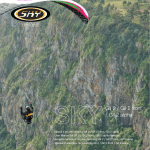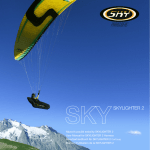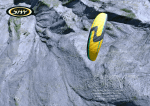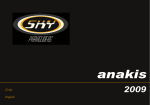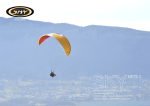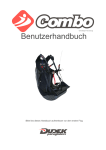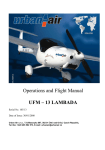Download REVERSE 3 - manuel
Transcript
REVERSE 3 Návod k použití sedačky REVERSE 3 User Manual for REVERSE 3 Harness Benutzerhandbuch für das REVERSE 3 Gurtzeug Manuel d‘utilisation de la REVERSE 3 CZ / EN / DE / FR Děkujeme Vám, že používáte výrobky SKY Paragliders. Jsme rádi, že jste se rozhodli pro sedačku REVERSE 3. Doufáme, že budete s tímto výrobkem spokojeni. Přejeme Vám krásné lety. Důrazně Vám doporučujeme, abyste si před prvním letem manuál důkladně přečetli. Pomůže Vám k rychlejšímu seznámení s výrobkem. Thank you for flying with a Sky Paragliders’ product. Thank you for purchasing the REVERSE 3 harness. We hope you will be satisfied with this product and wish you many memorable flights. It is strongly recommended that you consult the manual before the first flight. This manual will help you to quickly familiarise yourself with the product. Danke, dass Sie sich für ein Produkt von Sky Paragliders entschieden haben. Vielen Dank für den Kauf des REVERSE 3 Gurtzeugs. Wir hoffen, dass Sie mit diesem Produkt zufrieden sein werden und wünschen Ihnen viele unvergessliche Flüge. Es wird dringend empfohlen, dass Sie das Handbuch vor dem ersten Flug aufmerksam durchlesen. Diese Anleitung wird Ihnen helfen, sich rasch mit dem Produkt vertraut zu machen. Merci de voler avec un produit Sky Paragliders. Merci d‘avoir acheté une sellette REVERSE 3. Nous espérons que vous serez satisfait de ce produit et vous souhaitons de nombreux vols inoubliables. Il est fortement recommandé de consulter ce manuel avant le premier vol. Ce manuel vous aidera à vous familiariser rapidement avec le produit. Team Sky Paragliders 3 REVERSE 3 S, M, L, XL CZ / EN / DE / FR Obsah 4 Strana Content Page Inhalt Seite Index Page 5 20 35 50 Obsah Úvod ___________________________________________ 6 1. Všeobecné informace ____________________________ 6 2. Profil pilota ____________________________________ 6 3. Schéma _______________________________________ 7 4. Nastavení sedačky ______________________________ 8 1. Instalace záložního padáku ___________________ 8–11 5. Speed systém _________________________________ 12 6. Předletová kontrola _____________________________ 12 7. Start _________________________________________ 13 8. Přistání ______________________________________ 13 9. Bezpečnostní informace _________________________ 14 10. Údržba a kontroly _____________________________ 14 11. Příloha 1: Uložení kluzáku do batohové části sedačky ___ 15 12. Příloha 2: Vytažení kliky uvolňovače záložního padáku ___ 16 13. Příloha 3: Technické informace ___________________ 16 14. Příloha 4: Volitelné příslušenství ____________________ 17 Kontakt ________________________________________ 65 Česky> 5 INTRODUCTION 1 Úvod Sedačka REVERSE 3 je certifikována podle zkušebních osnov LTF 91/09 a EN 1651-1999. Všeobecné informace Model: REVERSE 3 Maximální letová hmotnost: viz technické údaje. UPOZORNĚNÍ Jakékoliv změny na postroji ruší výsledek Tato uživatelská příručka je platná k datu 1. května 2013. certifikace. Použití této sedačky je na Vaše vlastní riziko a jakákoliv odpovědnost výrobce nebo distributora je vyloučena. Pilot je odpovědný za letovou způsobilost postroje a musí jednat v souladu s platnými právními předpisy. 2 Profil pilota REVERSE 3 je určena pro: Piloty, kteří dávají přednost létání v poloze v sedě. Piloty, kteří často cestují a rádi kombinují létání s turistikou. Piloty, kteří preferují jednoduchá řešení na té nejvyšší úrovni. 6 3 REVERSE 3 Připojení záložního padáku Nastavení délky ramenních popruhů Boční seřízení Hlavní závěsné oko Nastavení úhlu sedací desky Kladka speed systému Klika k záložnímu padáku Hrudní a nožní popruhy s automatickou sponou Opěrka nohou 7 4 Nastavení sedačky 1) Instalace záložního padáku Důrazně doporučujeme, aby byla počáteční VAROVÁNÍ! instalace Po instalaci záložního padáku do sedačky záložního padáku provedena kvalifikovaným odborníkem. je naprosto nezbytné provést simulaci jeho odhození. Ujistíte se tím, že záložní systém funguje Požádejte svého dodavatele paraglidingového správně a k uvolnění záložního padáku dochází vybavení nebo instruktora, aby za Vás počáteční snadno. Segment s gumovými oky sloužící instalaci záložního padáku provedl a s procesem k uzavření kontejneru sedačky musí být pravidelně se seznamte. Velikost kontejneru pro záložní kontrolován. Je-li opotřebován, musí dojít k jeho padák u sedačky REVERSE 3 je vhodná pro výměně. většinu současných záložních systémů. Pokud není možné připojit kliku postroje na poutko Při každé instalaci záložního padáku zkontrolujte vnitřního záložního padáku, prosím obraťte se na pod zatížením 10 kg, zda je segment uzavření výrobce záložního systému, který by Vám měl kontejneru v pořádku. dodat vnitřní kontejner náhradní. Poutka mohou být přišitá na vhodné místo jakéhokoliv vnitřního Před každým letem zkontrolujte, zda jsou trny kontejneru. Musí to být ovšem provedeno pouze a klika správně umístěny. kvalifikovanou osobou. 8 9 Krok 1 Krok 2 Připojení volného konce záložního padáku. Vložte záložní padák do kontejneru sedačky a uzavřete chlopně. Krok 3 Krok 4 Kontejner uzavřete a zajistěte trny. Umístěte kliku na určené místo postroje, zajistěte suchým zipem. 10 2) Seřízení bočních popruhů 4) Nastavení hrudního popruhu Uvědomte si prosím, že poloha příliš „vleže“ snižuje stabilitu a zvyšuje riziko překroucení Utažení hrudního popruhu zvyšuje účinnost volných konců při zatáčení. autostabilizačního systému, avšak zároveň snižuje 3) Nastavení ramenních popruhů odezvu křídla. Pilot může pociťovat vyšší stabilitu v turbulentních podmínkách a křídlo bude také stabilnější v případě asymetrického kolapsu. Při zatáčení se pak bude křídlo méně naklánět. Pro pohodlí během vzletu a snadné dosažení ABS systém popruhů si však uchovává svou preferované letové pozice by ramenní popruhy stabilizační funkci prakticky za téměř libovolného neměly být příliš těsně utaženy. Ramenní popruhy nastavení hrudního popruhu. se mohou jevit volné při poloze vsedě, je však REVERSE 3 je vhodná pro piloty, kteří k řízení potřeba mít na paměti že při přílišném utažení svého křídla využívají převážně změny těžiště. může docházet k nežádoucímu tlaku popruhů při poloze, kdy budet ze sedačky vystupovat Upozornění: Nastavení hrudního popruhu může nebo budete potřebovat více natáhnout nohy být poměrně citlivé, je proto nejlepší vyzkoušet jej vpřed (např. při použití speed systému). nejprve na cvičném závěsu a v letu za bezvětří, nežli jej nastavovat při letu v turbulentním prostředí. Před startem nezapomeňte přednastavit hrudní popruh. Bude to mít za následek větší pohodlí za letu. 11 5 Speed systém 6 Předletová kontrola Nastavení speed systému POZOR! Speed systém by měl být nastaven na PARAGLIDING JE EXTRÉMNĚ NÁROČNÝ požadovanou délku za použití stojanu na SPORT VYŽADUJÍCÍ NEJVYŠŠÍ STUPEŇ sedačky. POZORNOSTI, ÚSUDKU A SEBEKÁZNĚ. PŘED KAŽDÝM LETEM ZKONTROLUJTE POZOR! BYŤ I SEBEMENŠÍ DROBNOSTI. Šňůra speed systému nesmí procházet klikou Zkontrolujte karabiny a ujistěte se, že jsou postroje. Šňůra musí procházet na straně záložního padáku, boční částí sedáku. automaticky uzavřeny systémem Twist lock. Zkontrolujte spony na nosném postroji, měly by se automaticky uzamknout. Nastavení postroje proveďte na stojanu k tomuto účelu určeném. Během individuálního nastavování se seznamte se všemi částmi sedačky. Seznamte se s pozicí a použití kliky záložního padáku. Zkontrolujte, zda je klika a jistící trny ve správné poloze. Další předletové kontroly: Ujistěte se, že nedochází k překřížení šňůr ani volných konců spojujících sedačku s kluzákem. Zkontrolujte správnou délku ramenních, nožních a hrudního popruhu. Zkontrolujte správné uzavření všech karabin. Znovu zkontrolujte kliku záložního systému. 12 7 Start 8 Přistání Před letem je velmi důležité přizpůsobit postroj V průběhu přiblížení na přistání přejděte ze tak, abyste v něm mohli snadno zaujmout letovou sedu do vzpřímené polohy. Toto by mělo být pozici hned po startu. provedeno s dostatečným předstihem, aby bylo možné předejít případným komplikacím při náhlé 1. Nasaďte si postroj. ztrátě výšky těsně před přistáním. Při přistání 2. Zapněte nejprve spony nožní, následně hrudní. v sedě existuje vysoké riziko poranění páteře. 3. Stlačte nožní popruhy dolů co možná nejvíce Za žádných okolností nespoléhejte na to, že je směrem ke kolenům a dotáhněte (v případě, že nožní popruhy necháte příliš vysoko, bude pro Vás obtížnější se po startu v sedačce posadit). 4. Pokud je to nutné, upravte ramenní popruhy. Nastavení ramenního popruhu závisí na výšce pilota (popruhy utáhněte tak, aby Vám při startu nebránily v pohybu). 5. Zkontrolujte zda jsou bederní popruhy upraveny tak, aby poskytovaly pohodlnou pozici za letu. 6. Zkontrolujte, zda je správně nastaven hrudní popruh. 7. Ujistěte se, že spony nožního a hrudního popruhu jsou správně uzavřeny (nesprávné uzavření spon je častou příčinou nehod). 13 sedačka vybavena chráničem. 9 Bezpečnostní informace 10 Údržba a kontroly 1) Létání nad vodou (SIV) 1) Tipy pro údržbu 2) Záruka Použití sedačky REVERSE 3 není vhodné Postroj je třeba pravidelně kontrolovat, zda Na REVERSE 3 je poskytována standardní v případě, že existuje riziko přistání ve vodě. Při nejeví známky opotřebení či poškození. přistání ve vodě s tímto typem chrániče vzniká Poškozené části musí být opraveny nebo vysoké riziko, že vztlak chrániče za zády pilota bude tlačit jeho hlavu pod vodu. Během SIV nebo letů nad vodou také doporučujeme použití záchranné vesty vybavené límcem, který udrží hlavu pilota nad hladinou i v případě náhlé ztráty vědomí. 2) Přistání vyměněny výrobcem. Karabiny by měly být vyměněňovány každých 5 let. Karabiny sedačky by nikdy neměly být použity záruka na jakoukoliv výrobní vadu po dobu 2 let od data prodeje koncovému zákazníkovi. Záruka se nevztahuje na: poškození způsobené nesprávným zacházením, nedbalostí, nedostatečnou údržbou nebo přetížením kluzáku (extrémní manévry). k jiným účelům než paraglidingu (horolezectví, tažení atd.). Veškeré opravy musí být prováděny výrobcem Záruka se rovněž nevztahuje na škody způsobené nesprávným přistání. nebo výrobcem pověřenou kvalifikovanou osobou a to vždy s použitím originálních Pokud máte pocit, že nerozumíte dostatečně Nikdy nepřistávejte v poloze vsedě, může to mít materiálů (šňůry, popruhy, přezky). některé části manuálu, prosím kontaktujte svého za následek vážná zranění. Chránič páteře není Zipové části by měly být čas od času pro takováto přistání určen. dealera SKY. promazány pomocí silikonového spreje. Postroj lze čistit pomocí měkkého kartáčku 3) Závěr a mýdla. Pokud Vám sedačka zmokne, je vhodné ošetřit automatické spony a karabiny silikonovým V nevhodných podmínkách se létání může stát sprejem. Toto může být samozřejmě čas od času nebezpečným, mějte proto vždy na paměti, prováděno bez ohledu na podmínky, ve kterých že Vaše bezpečnost je ve Vašich rukou. létáte. Nepodceňujte sílu a moc přírody. A v neposlední řadě si také létání nezapomeňte náležitě užít. Sky tým Vám přeje mnoho krásných letů a příjemný čas strávený s REVERSE 3. 14 11 15 PŘÍLOHA 1: Uložení kluzáku do batohové části sedačky 12 PŘÍLOHA 2: Vytažení kliky uvolňovače záložního padáku 13 PŘÍLOHA 3: Technické informace REVERSE 3 S M L XL Orientační výška pilota (cm) 152–168 163–183 175–196 188–210 Šířka sedací desky (cm) 32,5 34,9 37 39,5 Hloubka sedací desky (cm) 34,5 36,8 39 41,5 Výška závěsů (cm) 42 45 48 51 Rozsah seřízení hrudního popruhu (rozteč závěsů) (cm) 37–43 40–46 43–49 46–52 Hmotnost sedačky (kg) * 3,45 3,65 3,90 4,10 Certifikace EN/LTF EN/LTF EN/LTF EN/LTF * kompletní postroj – včetně hlavních karabin a speed systému 16 14 17 PŘÍLOHA 4: Volitelné příslušenství: a) REVERSE – speedbag PŘÍLOHA 4: Volitelné příslušenství: b) REVERSE – extra pocket 18 19 Content Introduction _____________________________________ 21 1. General Information _____________________________ 21 2. Pilot‘s Profile __________________________________ 21 3. Scheme _____________________________________ 21 4. Harness Set-Up ________________________________ 23 1. Positioning the Reserve Parachute _____________ 24–25 5. Speed System _________________________________ 27 6. Pre-flight Check ________________________________ 27 7. Take-Off ______________________________________ 28 8. Landing ______________________________________ 28 9. Safety Information ______________________________ 29 10. Maintenance & Checks _________________________ 29 11. Appendix 1: Reversing the Harness _______________ 30 12. Appendix 2: Reserve Deployment ________________ 31 13. Appendix 3: Technical Info ______________________ 31 14. Appendix 4: Optional Accessories ________________ 32 Contact ________________________________________ 65 English> 20 INTRODUCTION Introduction The harness REVERSE 3 conforms to the testing criteria of LTF 91/09 and EN 1651-1999. 1 General Information Model name: REVERSE 3 Total maximum weight in flight: see the technical data. PLEASE NOTE This user manual version dated 1 May 2013. Any changes to the harness will invalidate the certification. Use of this harness is at your own risk. Any liability of the manufacturer or distributor is excluded. The pilot is responsible for airworthiness of the aircraft. The pilot must comply with legal regulations. 2 Pilot‘s Profile REVERSE 3 is aimed at: Pilots who prefer a seated flying position. Travelling pilots and fly-hike pilots. Pilots who prefer a simple yet high-tech harness. 21 3 REVERSE 3 Reserve Attachement Lateral Adjustement Shoulder Adjustement Straps Main Suspention Points Seat Board Adjustment Pulley for Speed System Chest and Legs Straps with Automatic Buckles Reserve Handle Speed bar 22 4 Harness Set-Up 1) Reserve Parachute Installation The initial installation of the reserve parachu- WARNING! te should be carried out by a qualified pro- After installation of a reserve parachute fessional. in the harness, it is absolutely essential to do a simulated deployment under a static swing, We recommend that the initial installation of the ensuring that the parachute release system reserve parachute be done by a qualified operates correctly and the parachute comes out professional. Ask your paragliding equipment easily. The elastic cord which closes the reserve supplier or instructor to do the initial installation pocket must be checked regularly. If the cord is of the reserve parachute, and familiarise yourself worn, it must be replaced. with the process. The size of the reserve Each time a reserve parachute is installed, check pocket on REVERSE 3 is suitable for most that the cord is in good order by applying a load current reserve systems. If it is not possible to of 10 kg. connect the harness reserve handle to loops on Before each flight, check that the pin and handle the parachute deployment bag inside the pocket, are located correctly. please consult your supplier who may be able to supply an alternative deployment bag. Loops can be sewn at an appropriate place on any deployment bag, but this must be carried out by a qualified person only. 23 4 24 Positioning the Reserve Parachute Step 1 Step 2 Connecting the reserve risers. Place the reserve in the container and close the flaps. Step 3 Step 4 Close the pocket and locate the release pins. Locate the handle in the correct place on the harness. 25 2) Side Adjustment 3) Chest Strap Adjustment An excessively reclined position reduces Tightening the chest strap increases stability and increases the risk of risers twisting the efficiency of the Auto Balance System in the event of a spin. (stabilising system) but decreases the roll 3) Shoulder Strap Adjustment response of the wing. The pilot may feel more stable in turbulent conditions and the wing will be more stable in the event of an asymmetric For optimum comfort during take-off and ease collapse. However, the wing may be less of achieving your preferred flying position inclined to bank when turning. The design of the the shoulder straps should not be excessively integrated Auto Balance System in the REVERSE tight. The straps may appear loose while 3 means that the range of stabilisation in the seated position but some play is required in the chest strap remains reasonable. to avoid excessive strap pressure in the standing REVERSE 3 is suited to pilots who fly their wings position. using the weight-shift method. Warning: The chest strap adjustment can be quite sensitive and it is best to test first under a static swing, and then in still air flight, before trying to adjust it during a turbulent flight. Before taking off, do not forget to pre-adjust your chest strap. This will result in a more comfortable flight. 26 5 Speed System 6 Pre-flight checks Speed System Adjustment BEWARE! The speed system should be adjusted to PARAGLIDING IS AN EXTREMELY the correct length using a harness simulator. DEMANDING SPORT REQUIRING THE HIGHEST LEVEL OF ATTENTION, BEWARE! JUDGMENT, MATURITY, AND SELFDISCIPLINE. EVEN SMALL DETAILS The accelerator line must not run through SHOULD BE CAREFULLY CHECKED the reserve handle. The line must „run inside“ on BEFORE FLYING. the reserve side. To accomplish this REVERSE 3 has a special tube built into that side. Check the carabiners, and make sure that the twist lock system closes them automatically. Check the harness buckles; they should lock automatically. Adjust the harness using a harness hanger or simulator. When adjusting under the simulator you should make familiarise yourself with the harness and its parts. Test all adjustments, familiarise yourself with the position and use of the reserve handle. Check that the reserve handle and the pins are in the correct position. Further Pre-flight Checks: Ensure that there are no twists in the lines and risers that connect the harness to the glider. Check chest, side and shoulder straps adjustments. Ensure that all buckles are locked. Check your reserve handle. 27 7 Take-Off 8 Landing Before flying it is extremely important to adjust During the final approach move from the sitting the harness so that you can easily assume position to the upright position. This should be the right position when airborne. done early enough to allow for sudden loss of height on approach. There is a high risk 1. Put on the harness. of spinal injury in the event of a seated landing. 2. Fasten the leg buckles, and then the chest Under no circumstances become complacent strap buckle. 3. Push the leg straps down as far as possible towards the knees, and then tighten them (if the leg straps are too high, it is difficult to get into the harness after the take-off without using one’s hands). 4. If necessary, adjust the shoulder straps (the shoulder strap adjustment depends on the size of the pilot; not too tight as some free movement is required so that you can run easily). 5. Check that the lumbar straps are adjusted so as to enable the preferred position in flight. 6. Check that the chest strap is pre-adjusted correctly. 7. Ensure that the leg straps and the chest strap buckles are fastened correctly (closing the buckles improperly is a common cause of accidents). 28 about being equipped with effective protection. 9 Safety Information 10 Maintenance & Checks 1) Flying over water (SIV) 1) Maintenance Advice 2) Guarantee Do not use any kind of air based protection The harness should be checked regularly for REVERSE 3 is guaranteed for 2 years against any (Bumpair, Cygnus-type Airbag…) under any circumstances if there is a risk of landing in water. If you land in water using a bumpair, it‘s buoyancy behind the pilot creates a high risk of the pilot‘s head being pushed under the water. During SIV or flights over water, we recommend the use signs of wear and damage. Any damaged parts should be repaired or replaced by the manufacturer. The carabiners should be replaced every These carabiners should never be used for anything other than paragliding (not for keep the pilot’s head above water in the event climbing, towing etc.). 2) Landing The guarantee does not cover: Damage caused by misuse, neglect, insufficient maintenance, or overload of the glider (extreme manoeuvres). 5 years. of a lifejacket equipped with a collar which will of loss of consciousness. manufacturing fault from the date of purchase. All repairs should be carried out by the manufacturer or by qualified persons who The guarantee also does not cover any damage caused by inappropriate landings. If you are unsure about any information contained in this manual, please contact your SKY dealer. have been authorized by the manufacturer, and always using the original materials (thread, Never land in a seated position, it can result in serious injury, a back protector is not intended to replace landing gear. webbing, buckles). The zip fasteners should be lubricated from 3) Conclusion time to time, using a silicone spray. Aircraft can become dangerous in unsuitable The harness may be cleaned using mild soap flying conditions always remember that your and a soft brush. If your harness gets wet, it is security lies in your hands. Do not underestimate advisable to treat your automatic buckles and the power and force of nature. carabineers with silicone grease. This may also be done as a matter of course from time to time. Last, but not least, do not forget to enjoy your flying. The SKY Team wishes you many exciting flights and happy times with your REVERSE 3. 29 11 30 APPENDIX 1: Reversing the Harness 12 APPENDIX 2: Reserve Deployment 13 APPENDIX 3: Technical Info REVERSE 3 S M L XL Pilot`s Height (cm) 152–168 163–183 175–196 188–210 Board Width (cm) 32,5 34,9 37 39,5 Board Depth (cm) 34,5 36,8 39 41,5 Suspension Points height (cm) 42 45 48 51 Chest Strap Range (cm) 37–43 40–46 43–49 46–52 Harness Weigh (kg) * 3,45 3,65 3,90 4,10 Test EN/LTF EN/LTF EN/LTF EN/LTF * Total weight including speed system and main carabines. 31 14 32 APPENDIX 4: Optional Accessories: a) REVERSE – speedbag APPENDIX 4: Optional Accessories: b) REVERSE – extra pocket 33 34 Inhalt Einführung _____________________________________ 36 1. Allgemeine Informationen ________________________ 36 2. Pilotenprofil ___________________________________ 36 3. Schema ______________________________________ 37 4. Einstellung ____________________________________ 38 1. Montage des Rettungsschirmes _______________ 39–40 5. Speedsystem _________________________________ 42 6. Vorflugcheck __________________________________ 42 7. Start _________________________________________ 43 8. Landen ______________________________________ 43 9. Informationen zur Sicherheit ______________________ 44 10. Wartung & Checks ____________________________ 44 11. Anhang 1: Das Wenden des Gurtzeuges ___________ 45 12. Anhang 2: Wie der Rettungsschirmgriff auszulosen ist _ 46 13. Anhang 3: Technische Daten ____________________ 46 14. Anhang 4: Optionales Zubehör ___________________ 47 Kontakt ________________________________________ 65 Deutsch> 35 INTRODUCTION Einführung Das Gurtzeug REVERSE 3 entspricht den Testkriterien der LTF 91/09 und den Prüfkriterien der EN 1651-1999. 1 Allgemeine Informationen REVERSE 3 Maximal zulässiges Startgewicht: siehe technische Daten. Diese Bedienungsanleitung datiert vom BITTE BEACHTEN 1. Mai 2013 Alle Änderungen am Gurtzeug haben ein Erlöschen der Musterprüfung zur Folge. Die Nutzung dieses Gurtzeugs erfolgt auf eigene Gefahr. Eine Haftung des Herstellers oder Vertriebs ist ausgeschlossen. Der Pilot ist verantwortlich für die Lufttüchtigkeit seiner Flugausrüstung. Der Pilot muss den gesetzlichen Vorschriften entsprechen. 2 Pilotenprofil Das REVERSE 3 richtet sich an: Piloten, die eine sitzende Flugposition bevorzugen Reisende Piloten und Freunde von Walk & Fly Piloten, die ein einfaches, dabei aber technisch ausgefeiltes Gurtzeug bevorzugen 36 3 REVERSE 3 Rettungsleinen Seitlicher Brustgurt Schultergurte Hauptaufhängung Sitzbrettstützung Umlenkrollen für Beschleuniger Brustgurt und Beinschlaufe mit Automatikschnallen Rettungsgriff Beschleunigersystem 37 4 Einstellung 1) Montage des Rettungsschirmes WARNUNG! Die Erstinstallation der Rettungsschirmes Nach der Installation eines Rettungsschirm im sollte von einem qualifizierten Fachmann Gurtzeug ist es unbedingt erforderlich, eine durchgeführt werden. Probeauslösung mit im Gurtzeug sitzendem Piloten durchzuführen, um sicherzustellen, dass Wir empfehlen, den Einbau des Retters auslösen lässt. Die elastische Schnur, welche Fachmann durchführen zu lassen. Bitten Sie das Retterfach schließt, muss regelmäßig Ihren Ausrüstungsverkäufer oder Lehrer um überprüft werden. Wenn die Schnur beschädigt die Erstinstallation des Rettungsschirmes und ist muss sie ersetzt werden. machen Sie sich mit dem Prozess vertraut. Die Prüfen Sie bei jedem Einbau des Rettungsschirms Größe des Rettungsschirmfachs des REVERSE diese Schnur durch Aufbringen einer Last von 3 eignet sich für die meisten aktuellen Systeme. 10 kg auf ihren Zustand. Überprüfen Sie vor Wenn es nicht möglich ist, den Rettungsschirmgriff jedem Flug, ob sich Aulösesplint und Griff in der des Gurtzeugs mit Schlaufen am Innencontainer korrekten Position befinden. des Retters zu verbinden, fragen Sie bitte Ihren Anbieter nach einem geeigneten Innencontainer. Schlaufen können an einem geeigneten Ort auf jeden Innencontainer genäht werden, aber dies darf nur von einer qualifizierten Person durchgeführt werden. 38 sich der Fallschirm leicht ziehen und korrekt in das Gurtzeug von einem qualifizierten 39 Schritt 1 Schritt 2 Anschließen der Tragegurte. Legen Sie den Retter in den Behälter und schließen Sie die Klappen. Schritt 3 Schritt 4 Schließen Sie das Retterfach und suchen Sie nach den Auslösesplinten. Positionieren Sie den Griff an der richtigen Stelle auf dem Gurt. 40 2) Einstellung auf der Seite 4) Brustgurteinstellung Eine zu liegende Position reduziert die Stabilität Das Anziehen des Brustgurtes erhöht und erhöht das Risiko von eingedrehten die Effizienz des Auto-Balance-Systems Tragegurten im Fall des Trudelns. (Stabilisierungssystem), aber verringert das 3) Schultergurteinstellung Ansprechen des Schirms auf Gewichtssteuerung. Der Pilot wird sich in turbulenten Bedingungen sicherer fühlen und der Schirm wird stabiler im Für optimalen Komfort während des Starts und Falle eines einseitigen Einklappers. Allerdings einfaches Erreichen Ihrer bevorzugten Position ist der Schirm weniger bereit, beim Drehen sollten die Schultergurte nicht übermäßig fest Schräglage aufzunehmen. Das im REVERSE 3 sein. Die Gurte können Ihnen im Sitzen locker eingesetzte ABS-System erlaubt daher nur einen erscheinen, aber etwas Spiel ist erforderlich, um vernünftigen Einstellbereich des Brustgurtes. übermäßigen Druck des Gurtes im Stehen zu Das REVERSE 3 eignet sich für Piloten, die ihre vermeiden. Schirm über die Gewichtsverlagerung fliegen. Achtung: Die Brustgurteinstellung kann sehr empfindlich reagieren, weshalb es am besten ist, sie zuerst unter einer Schaukel oder in ruhiger Luft zu testen, bevor Sie versuchen, sie während eines turbulenten Fluges anzupassen. Vergessen Sie vor dem Start nicht auf die Voreinstellung Ihres Brustgurtes. Das Ergebnis wird ein komfortablerer Flug sein. 41 5 Speedsystem 6 Vorflugcheck Einstellung des Speedsystems ACHTUNG! Der Fußbeschleuniger sollte in einem GLEITSCHIRMFLIEGEN IST EIN ÄUSSERST Gurtzeugsimulator auf die richtige Länge ANSPRUCHSVOLLER SPORT, DER EIN eingestellt werden. HÖCHSTMASS AN AUFMERKSAMKEIT, URTEILSVERMÖGEN, REIFE UND ACHTUNG! SELBSTDISZIPLIN ERFORDERT. AUCH KLEINSTE DETAILS SOLLTEN VOR DEM Die Beschleunigerleine darf nicht durch den Griff der Reserve laufen. Die Leine muss auf der Innenseite des Retters verlaufen. Um dies sicherzustellen ist das REVERSE 3 mit einer speziellen Röhre ausgestattet. FLUG SORGFÄLTIG ÜBERPRÜFT WERDEN. Überprüfen Sie die Karabiner, und stellen Sie sicher, dass das Twist-Lock-System sie automatisch verschließt. Überprüfen Sie die Gurtschlösser; sie sollten automatisch verriegeln. Stellen Sie das Gurtzeug in einer Schaukel oder einem Flugsimulator ein. Bei der Einstellung unter dem Simulator können das Gurtzeug und seine Bestandteile kennen lernen. Testen Sie alle Einstellungen, machen Sie sich mit der Position und der Verwendung des Rettungsschirmgriffes vertraut. Überprüfen Sie, dass sich der Griff und die Splinte in der richtigen Position befinden. Weitere Vorflugchecks: Stellen Sie sicher, dass sich keine Verdrehungen in den Leinen und Tragegurten, welche das Gurtzeug mit dem Schirm verbinden, befinden. Prüfen Sie die Einstellungen der Brust-, Seitenund Schultergurte. Vergewissern Sie sich, dass alle Schnallen verschlossen sind. Überprüfen Sie Ihren Rettungsschirmgriff. 42 7 Start 8 Landung Vor dem Flug ist es äußerst wichtig, das Gurtzeug Bewegen Sie sich während des Endanflugs aus der so anzupassen, dass Sie in der Luft leicht eine Sitzposition in eine aufrechte Position. Dies sollte sitzende Position einnehmen können. früh genug geschehen, um für einen plötzlichen Höhenverlust gewappnet zu sein. Es besteht ein 1. Legen Sie das Gurtzeug an. hohes Risiko von Rückenmarksverletzungen bei 2. Schließen Sie erst die Beinschlaufen, dann den einem sitzenden Aufprall. Verlassen Sie sich auf Brustgurt. 3. Drücken Sie die Beingurte so weit wie möglich in Richtung der Knie und ziehen Sie sie dann zu (wenn die Beingurte zu weit oben sind, ist es schwierig, ohne Verwendung der Hände nach dem Start in das Gurtzeug zu gelangen). 4. Falls erforderlich, justieren Sie die Schultergurte (die Einstellung hängt von der Größe des Piloten ab; nicht zu eng, da für ungehindertes Laufen eine gewisse Bewegungsfreiheit erforderlich ist). 5. Überprüfen Sie, dass die Einstellung der Seitengurte die Einnahme ihrer bevorzugten Sitzposition im Flug erlauben. 6. Prüfen Sie, ob der Brustgurt richtig voreingestellt ist. 7. Stellen Sie sicher, dass die Beingurte und die Brustgurtschnalle richtig geschlossen sind (Ein unsachgemäßes Schließen dieser Schnallen ist eine häufige Unfallursache). 43 keinen Fall blind auf den effizienten Protektor. 9 Informationen zur Sicherheit 1)Fliegen über Wasser (Sicherheitstraining ..) 10 Wartung & Checks 1) Wartungshinweise 2) Garantie Der Gurt sollte regelmäßig auf Anzeichen von Das REVERSE 3 unterliegt für 2 Jahre ab Verwenden Sie keinerlei Art von luftbasiertem Verschleiß und Beschädigungen überprüft Kaufdatum einer Garantie gegen Fabrikationsfehler. Schutz (Bumpair, Cygnus-Airbag ...), wenn die werden. Die Garantie gilt nicht für: Schäden, die durch Gefahr einer Landung im Wasser besteht. Bei einer Wasserung mit Airbag bewirkt dieser einen Auftriebsschwerpunkt hinter dem Piloten, wodurch ein hohes Risiko ensteht, dass der Kopf des Piloten unter Wasser gedrückt wird. Beschädigte Teile sollten repariert oder vom Hersteller ersetzt werden. Die Karabiner sollten alle 5 Jahre ausgetauscht werden. Diese Karabiner dürfen nie für etwas anderes Missbrauch, Vernachlässigung, unzureichende Wartung oder Überlastung der Ausrüstung (extreme Manöver) verursacht wurde. Die Garantie deckt auch keine Schäden, die durch unsachgemäße Landungen verursacht wurden. Bei Sicherheitstrainings oder Flügen über als Gleitschirmfliegen verwendet werden (nicht Wenn Sie bezüglich Informationen in diesem Wasser empfehlen wir die Verwendung einer zum Klettern, Abschleppen usw.). Handbuch unsicher sind wenden Sie sich bitte an Rettungsweste mit Kragen, die den Kopf des Alle Reparaturen sollten nur vom Hersteller Piloten bei Bewusstlosigkeit über Wasser hält. oder von qualifizierten Personen, die vom Hersteller autotisiert wurden, und immer mit 2) Landung den ursprünglichen Materialien (Nähfaden, Ihren SKY Händler. 3) Fazit Gurtband, Schnallen) durchgeführt werden. Landen Sie nie in einer sitzenden Position; dies kann zu schweren Verletzungen führen - ein Die Reißverschlüsse sollten von Zeit zu Zeit mit einem Silikonspray geölt werden. Sie in unsicheren Flugbedingungen immer daran, dass Ihre Sicherheit in Ihren Händen liegt. Rückenprotektor ist nicht dafür gedacht, das Fahrwerk zu ersetzen. Jedes Fluggerät kann gefährlich werden - denken Der Gurt kann mit milder Seife und einer weichen Unterschätzen Sie nicht die Kraft und die Gewalt Bürste gereinigt werden. Wenn Ihr Gurtzeug nass der Natur. wird, ist es ratsam, Ihre Automatikschnallen und Zu guter Letzt, vergessen Sie nicht, Ihre Flüge zu Karabiner mit Silikonfett behandeln. Dies kann genießen. auch als regelmäßige Instandhaltung gemacht werden. Das SKY-Team wünscht Ihnen viele spannende Flüge und glückliche Zeiten mit Ihrem REVERSE 3. 44 11 45 ANHANG 1: Das Wenden des Gurtzeuges 12 ANHANG 2: Wie der Rettungsschirmgriff auszulosen ist 13 ANHANG 3: Technische Daten REVERSE 3 S M L XL Pilotengröße (cm) 152–168 163–183 175–196 188–210 Sitzbrett-Breite (cm) 32,5 34,9 37 39,5 Sitzbrett-Tiefe (cm) 34,5 36,8 39 41,5 Höhe Karabineraufhängung (cm) 42 45 48 51 Breite Brustgurt (cm) 37–43 40–46 43–49 46–52 Gurtgewicht* (kg) 3,45 3,65 3,90 4,10 Test EN/LTF EN/LTF EN/LTF EN/LTF * Das Gesamtgewicht umfasst (Gurtzeug, Karabiner, Speedsystem) 46 14 47 ANHANG 4: Optionales Zubehör: a) REVERSE – speedbag ANHANG 4: Optionales Zubehör: b) REVERSE – extra pocket 48 49 Index Introduction ______________________________________ 51 1. Informations générales ___________________________ 51 2. Profil du pilote __________________________________ 51 3. Vue _________________________________________ 52 4. Installation Votre Sellette _________________________ 53 1. Installation du parachute de secours ___________ 54–55 5. Accélérateur __________________________________ 57 6. Vérifications avant le vol _________________________ 57 7. Décollage ____________________________________ 58 8. Atterrissage ___________________________________ 58 9. Informations sur la sécurité _______________________ 59 10. Maintenance & Contrôles _______________________ 59 11. Annexe 1 : Retourner la sellette ___________________ 60 12. Annexe 2 : Comment tirer la poignée parachute ______ 61 13. Annexe 3 : Informations techniques _______________ 61 14. Annexe 4 : Accessoires optionnels ________________ 62 Contact ________________________________________ 65 Française> 50 INTRODUCTION Introduction Ce harnais est conformeaux criteres de test de la LTF 91/09 et de la norme EN 1651-1999. 1 Informations générales Nom du model : REVERSE 3 poids total maximum en vol : voir les caractéristiques techniques IMPORTANT : date version du mode d‘emploi : 1er mai 2013. Toute modification de cette sellette annulera son homologation. L‘utilisation de cette sellette est sous votre entière responsabilité. Toute responsabilité du fabricant ou du distributeur est exclue. Le pilote est responsable de la navigabilité de son aéronef. Le pilote doit se conformer aux législations en vigueurs. 2 Profil du pilote La REVERSE 3 est destinée à : des pilotes qui aiment voler en position assise des pilotes qui voyagent et pratiquent les vols – randonnée ; les pilotes qui aiment les sellettes simple et de haute technicité. 51 3 REVERSE 3 Attaches parachute Réglage latéral Réglages d‘épaule Points d‘attache principaux Réglage d‘assiette du plateau Poulies passage accélérateur Boucles automatiques ventrale et cuissardes Poignée parachute Accélérateur 52 4 Installation de votre sellette 1) Installation du parachute de secours ATTENTION ! La première installation du parachute Après l‘installation d‘un parachute de secours de secours doit être effectuée par un dans le harnais, il est absolument essentiel professionnel qualifié. de faire une simulation d‘extraction sous un portique, pour vous assurer que le parachute Nous recommandons que l‘installation initiale du peux être extrait librement et sans gêne. Le parachute soit effectuée par un professionnel cordon élastique qui ferme la poche parachute qualifié. Demandez à votre revendeur ou à doit être vérifiée régulièrement. votre instructeur de faire l‘installation initiale du Si le cordon est usé, il doit être remplacé. parachute de secours, et de vous familiariser Chaque fois qu‘un parachute de secours est avec ce processus. La taille de la poche installé, vérifiez que le cordon est en bon état en parachute de la REVERSE 3 est adaptée à appliquant une traction de 10 kg. Avant chaque différentes tailles de parachute de secours. S‘il vol, vérifiez que les aiguilles et la poignée sont n‘est pas possible de connecter la poignée la correctement positionnées. poignée parachute à une boucles du „POD“ (container de déploiement) du parachute, demandez à votre revendeur de vous fournir un container de déploiement adapté. Une boucle peut être cousue sur la poche de déploiement, mais cette opération ne peut être réalisé que par un opérateur qualifié. 53 54 Étape 1 Étape 2 Connectez les élévateurs. Placez le parachute et fermez les volets. Étape 3 Étape 4 Fermez la poche et positionnez les aiguilles de libération. Installez la poignée dans son logement. 55 2) Ajustement latéral 4) Réglage de la ceinture ventrale Une position trop inclinée réduit la stabilité et augmente le risque de twist. 6) Réglage des sangles d‘épaules Serrrer la sangle ventrale permet d‘améliore l‘efficacité du système „Anti Balance Systeme“ (système de stabilisation), mais diminue la réponse en roulis de l‘aile. Le pilote peut se sentir plus stable en conditions turbulentes et l‘aile Pour un confort optimal pendant le décollage et sera plus stable dans le cas d‘une fermeture passer facilement en position assises, les sangles asymétrique. Cependant, l‘aile se pilotera moins d‘épaules ne doivent pas être trop serrées. Les à la sellette en virages. La conception de „l‘Anti sangles peuvent apparaître lâches en position Balance Systeme“ intégrée de la REVERSE 3 est assise, mais un certain jeu de réglage est efficace et raisonnable. nécessaire pour éviter une pression excessive en La REVERSE 3 est adaptée aux pilotes qui position debout. aiment piloter leurs ailes à la sellette. Attention : Le réglage de la sangle ventrale peut être très sensible et il est préférable de le tester d‘abord sous portique, puis en air calme, avant d‘essayer de le régler au cours d‘un vol turbulent. Avant le décollage, n’oubliez pas de prérégler votre ventrale. Cela se traduira par un vol plus confortable. 56 5 Accélérateur 6 Vérifications avant le vol Réglage de l‘accélérateur ATTENTION ! L‘accélérateur doit être réglé à la longueur LE PARAPENTE EST UN SPORT TRÈS correcte à l‘aide d‘un simulateur de vol ou sous EXIGEANT QUI DEMANDE UNE GRANDE un portique. CONCENTRATION, DE LA MATURITÉ, DU SANG FROID MAIS AUSSI BEAUCOUP DE ATTENTION ! BON SENS. QUELQUES DÉTAILS MÉRITENT D‘ÊTRE CONTROLÉS AVEC LA PLUS La cordelette d‘accélérateur ne doit pas passe GRANDE ATTENTION vers la poignée parachute. Du côté de la poche parachute, la cordelette passe à l‘intérieur de Vérifiez les mousquetons, et assurez-vous que la sellette. Pour ce faire, un espace spécial est le système de verrouillage par rotation ferme prévu sur la REVERSE 3. automatiquement. Vérifiez les boucles du harnais, elles doivent se verrouiller automatiquement. Réglez la sellette sous un portique ou un simulateur de vol. Lors de cet essai, sous portique, familiarisez-vous avec les différents réglages de votre sellette. Testez les différents réglages et familiarisez-vous avec la position de la poignée parachute. Vérifier que la poignée du parachute secours et que les aiguilles soient en position correcte. Autres vérifications avant le vol : Assurez-vous qu‘il n‘y a pas de „twist“ dans les suspentes et les élévateurs qui relient la sellette et l‘aile Vérifiez les réglages latéraux et de sangle ventrale. Veiller à ce que toutes les boucles soient verrouillées. Vérifiez votre poignée de parachute de secours. 57 7 Décollage 8 Atterrissage Avant le décollage, il est extrêmement important Pendant l‘approche finale, passez de la position que la sellette soit ajustée correctement afin que assise à la position debout. Cela devrait être vous passiez facilement dans une position assise fait assez tôt pour prévenir une perte soudaine confortable. d‘altitude lors de l‘approche. Il ya un risque élevé de lésions de la colonne vertébrale en cas 1. Enfilez la sellette. d‘atterrissage en position assise. En aucun cas, 2. Fermez les cuissardes, puis la ventrale. même équipé d‘une protection, n‘atterrissez pas 3. Descendez les cuissardes aussi bas que en position assise. possible vers les genoux, puis serrez-les (si les cuissardes sont trop haute, il est difficile de s‘assoir automatiquement dans la sellette, après le décollage, sans utiliser ses mains). 4. Si nécessaire, ajustez les sangles d‘épaules (le réglage des sangles d‘épaules dépend de la taille du pilote, ne les serrez pas trop afin de rester libre de vos mouvement). 5.Vérifiez que les sangles latérales soient ajustées de manière à permettre la position souhaitée en vol. 6.Vérifiez que la ventrale soit correctement préréglée. 7. Assurez-vous que les cuissardes et les boucles ventrales soient correctement fermée (La non fermeture des boucles est une cause fréquente d‘accidents). 58 9 Informations sur la sécurité 1) Voler au-dessus de l‘eau (SIV...) N‘utilisez en aucun cas une protection à base d‘air (Bumpair, Cygnus type Airbag ...) si il ya un risque d‘atterrissage dans l‘eau. En atterrissant dans l‘eau avec un Bumpair, la ligne de flottabilité est à l‘arrière du pilote et le risque est fort que sa tête soit maintenue sous l‘eau. Lors de stage SIV 10 Maintenance & Contrôles 1) Conseils d‘entretien 2) Garantie La sellette doit être vérifiée régulièrement pour La REVERSE 3 est garanti 2 ans contre tous dé- prévenir usure et dommages. Les pièces endommagées doivent être réparées ou remplacées par le fabricant. Les mousquetons doivent être remplacés tous les 5 ans. fauts de fabrication à compter de la date d‘achat. La garantie ne couvre pas : les dommages causés par une mauvaise utilisation, une négligence, un entretien insuffisant, ou surcharge de l‘aile (manœuvres extrêmes). Les mousquetons ne doivent jamais ou vols sur l‘eau, nous recommandons l‘utilisation être utilisés pour autre chose (escalade, La garantie ne couvre pas les dommages d‘un gilet de sauvetage équipé d‘un collier qui remorquage, etc.) que le parapente causés par des atterrissages sur les fesses ou aidera à garder la tête du pilote au-dessus de l‘eau en cas de perte de conscience. 2) Atterrissage Ne jamais atterrir assis, il peut en résulter des Toutes les réparations doivent être effectuées inappropriés. par le fabricant ou par des personnes qualifiées qui ont été autorisées par le Si vous n‘êtes pas sûr de toute information con- fabricant, et toujours en utilisant les matériaux tenue dans ce manuel, s‘il vous plaît contactez d‘origine (fil, sangles, les boucles). votre revendeur SKY. Les fermetures à glissière doivent être blessures graves, une protection dorsale n‘a pas lubrifiées de temps à autre, à l‘aide d‘un spray pour fonction de remplacer le train d’atterrissage. de silicone. 3) Conclusion Le harnais peut être nettoyé avec un savon Les sports aériens peuvent devenir dangereux doux et une brosse souple. Si votre harnais est dans des conditions de vol inappropriés rap- mouillé, il est conseillé de traiter vos boucles pelez-vous toujours que votre sécurité est entre automatiques et mousquetons avec de la vos mains. Ne sous estimez pas les facteurs graisse de silicone. Cela peut également être fait externes. périodiquement de temps à autre. Enfin, n‘oubliez pas de profiter de votre vol. Le Sky Team vous souhaite beaucoup de vols passionnants et des moments heureux avec votre REVERSE 3. 59 11 60 ANNEXE 1 : Retourner la sellette 12 ANNEXE 2 : Comment tirer la poignée parachute 13 ANNEXE 3 : Informations techniques REVERSE 3 S M L XL Taille du pilote (cm) 152–168 163–183 175–196 188–210 Largeur plateau (cm) 32,5 34,9 37 39,5 Profondeur plateau (cm) 34,5 36,8 39 41,5 Hauteur des points d‘ancrages (cm) 42 45 48 51 Ecartement ventrale (cm) 37–43 40–46 43–49 46–52 Poids de la sellette* (kg) 3,45 3,65 3,90 4,10 Homologation EN/LTF EN/LTF EN/LTF EN/LTF * Le poids de la sellette comprend les mousquetons et l‘accélérateur 61 14 62 ANNEXE 4 : Accessoires optionnels : a) REVERSE – speedbag ANNEXE 4 : Accessoires optionnels : b) REVERSE – extra pocket 63 64 Kontakt / Contact Sky Paragliders a.s. Okružní 39 739 11 Frýdlant nad Ostravicí Czech Republic Tel. + 420 558 676 088 [email protected] www.sky-cz.com 65 © 2013 Sky Paragliders a.s.


































































